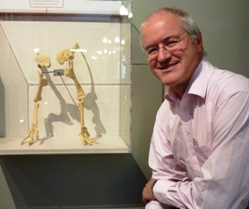
Ian Randall attends the launch in Bristol of a new scheme to reconstruct Britain’s oldest known
dinosaur.
Geoscientist Online 12 November 2009
Bristol University has launched a scheme to free the bones of Britain’s oldest dinosaur.
The scheme, a central aim of which is to involve the public, is funded by a £295,000 grant from the Heritage Lottery Fund. Bristol University owns around four tonnes of dinosaur-containing Upper Triassic rock that need opening up. Five hundred bones, from females, males and juveniles, have already been extracted from the host rocks.
The Heritage Lottery Fund, which celebrates its 15th anniversary this year, exists to maintain and promote our heritage, using funds raised through the National Lottery. Head of HLF South West, Nerys Watts, said: “The remains of the Bristol Dinosaur are of international scientific and heritage importance, offering a chance for us to further understand what our world was once like.”
Thecodontosaurus antiquus, whose name literally means ‘ancient socket-tooth reptile’, was a primitive dinosaur that roamed prehistoric Bristol 216 million years ago. The creature, which measured about two metres in length, was a herbivore.
Professor Mike Benton of Bristol University told Geoscientist Online that they were "extremely grateful for the funding", and that it was excellent that it is “accepted that geology, the Earth sciences and dinosaurs are a legitimate part of our heritage. “Heritage” is what belongs to all of us - our common possessions”.